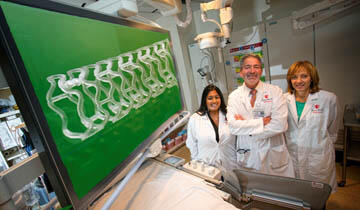Stony Brook Heart Institute Evaluates First Dissolvable Stent
Clinical trial compares new device with standard metallic drug-eluting stents and investigates vasomotion, a measure of how much natural motion returns to the vessel
STONY BROOK, NY, September 20, 2013 — Specialists at Stony Brook University Heart Institute have launched a clinical trial investigating the first cardiovascular stent that opens a heart vessel the same way as metallic stents but then dissolves away naturally. The new stent could prove to have benefits over standard metallic drug-eluting stents in relation to vessel blood flow and how much natural motion returns to the vessel after it dissolves. Coronary artery disease (CAD) is the leading cause of death for men and women in the United States.
For patients who do not require open heart surgery to open blocked blood vessels, inserting metallic drug-eluting stents is standard therapy. Stony Brook specialists will compare the efficacy and safety of Absorb™, a drug-eluting bioresorbable vascular scaffold (BVS) manufactured by Abbott, to standard metallic drug-eluting stents in two groups of patients. Absorb will only be used in patients whose condition enables them to elect for the dissolvable stent. The principal investigator leading the trial at Stony Brook is Luis Gruberg, MD.
"This type of coronary stent that 'disappears' is the latest technology to treat vessel blockages," said Dr. Gruberg, professor of medicine, division of cardiovascular medicine, and director of research, interventional cardiology, at Stony Brook University School of Medicine. "Unlike metallic stents that stay within the vessels permanently, this stent completely dissolves within about two years after implantation and may promote natural vessel motion to the treated tissue."
 Dr. Luis Gruberg, center, leads a Stony Brook University Heart Institute clinical trial to evaluate the first dissolvable cardiovascular stent, called Absorb, shown magnified on the screen. Also pictured are research coordinators Melissa Ramgadoo, BS, left, and Lynda Enden, RN, CCRC.
Dr. Luis Gruberg, center, leads a Stony Brook University Heart Institute clinical trial to evaluate the first dissolvable cardiovascular stent, called Absorb, shown magnified on the screen. Also pictured are research coordinators Melissa Ramgadoo, BS, left, and Lynda Enden, RN, CCRC.
The ABSORB III clinical trial will enroll approximately 2,250 patients. At Stony Brook, Dr. Gruberg expects to enroll 30 to 40 patients. Eligibility is based on non-emergency cases with simple blockages in the coronary arteries. Men or women of any age in need of stent implantation may be eligible.
Dr. Gruberg said that the BVS technology and the device acting as a "temporary scaffold" to the vessel is designed to result in more vessel flexibility compared to vessels with permanent metallic stents. He explained that the potential end result is a dissolved stent with a vessel that has enhanced pulsation similar to a normal, unblocked blood vessel. To determine this endpoint, Dr. Gruberg will evaluate vasomotion, a measure of how much natural motion returns to the vessel in patients treated with Absorb once the new device dissolves into arterial tissue.
A unique aspect of the BVS stent is that it is made of polylactide, a naturally dissolvable material derived from products like corn starch, which is commonly used in medical implants such as dissolving sutures. After the drug-eluting stent dissolves only two pairs of tiny metallic markers are left behind to enable a physician to identify where the device was implanted.
For more information about this clinical trial and enrollment at Stony Brook, please call the Stony Brook University Heart Institute Research Office at 631-444-3309.

